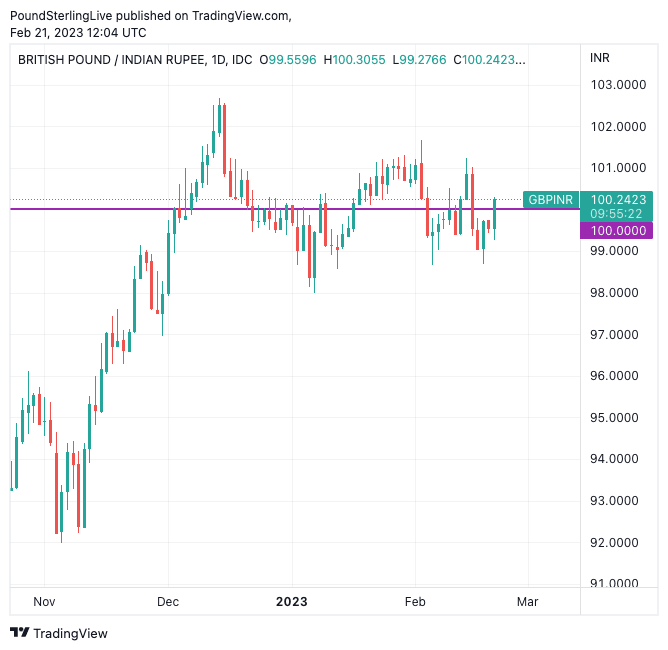Pound-Rupee Tests 100 Level, But a Break Could be Fleeting
- Written by: Gary Howes
-

Image © Adobe Images
The Pound to Rupee exchange rate rose through the 100 level following stronger-than-expected UK data out Tuesday, although strategists are looking for Rupee outperformance in the coming weeks and months.
The findings suggest any breaks through the 100 figure might prove short-lived.
"Sterling strengthened sharply," says Asmara Jamaleh, an economist at Intesa Sanpaolo, "following domestic PMIs, that surprised positively, outlining a much stronger increase than expected."
The Pound-Indian Rupee exchange rate reached 100.205 following a 0.70% rally on February 21.
The ascent in spot takes the rate on typical bank payments to 96.71-97.42. For remittances, rates of 99.373 GBP/INR are now possible, according to the Ria Money Transfer App.
The Pound rose as markets adjusted their expectations for further Bank of England interest rate hikes following the stronger-than-expected data.
The Bank might have to hike rates by a further 50 basis points before the current cycle is over according to the latest pricing on international money markets.
The lift in hike expectations has raised UK bond yields, in turn, offering support to the Pound.
The gains in GBP/INR come amidst a period of soft performance for INR, but some analysts are looking for a rebound.
Looking ahead, foreign exchange strategists at Bank of America say the Rupee has been underperforming rivals in the Emerging Market space of late, but it should see some upside over the coming weeks.
"Indian rupee performance is underwhelming due to a combination of poor portfolio inflows and a step-up in Reserve Bank of India FX reserves. We do expect INR appreciation to play catch-up, albeit at a gradual pace as the carry theme sustains," says Claudio Piron, an analyst at Bank of America Merrill Lynch in Singpaore.
Michael Loh, Emerging Market and Asia FXLM Strategist at BNP Paribas, also says the Rupee has underperformed.
Above: GBP/INR at daily intervals.
"INR has underperformed expectations since the start of the year. USDINR has been unseasonably stodgy, despite stronger risk sentiment, a weaker dollar, unthreatening oil prices, and even a well-crafted budget," says Loh.
The analyst says several factors contributed to the underperformance:
- restocking of FX reserves
- potential rotation of global equity portfolio flows towards China,
- rising domestic risk premium
Nevertheless, Loh says the underperformance should not be a concern.
"With the US FOMC scaling back hawkish surprises, we expect the dollar to continue to soften over the medium term. In turn,
this would allow EM policymakers a larger buffer," he says.
BNP Paribas expects some authorities to welcome the opportunity to gain some competitive advantage via a cheaper currency without the risk of a serious deterioration in sentiment.
"In the case of India, the RBI has proved adept at containing rupee volatility by deploying substantial FX reserves," says Loh.
BNP Paribas tells clients it continues to look at the Rupee's recent underperformance "as a potential opportunity to position for strength later".


